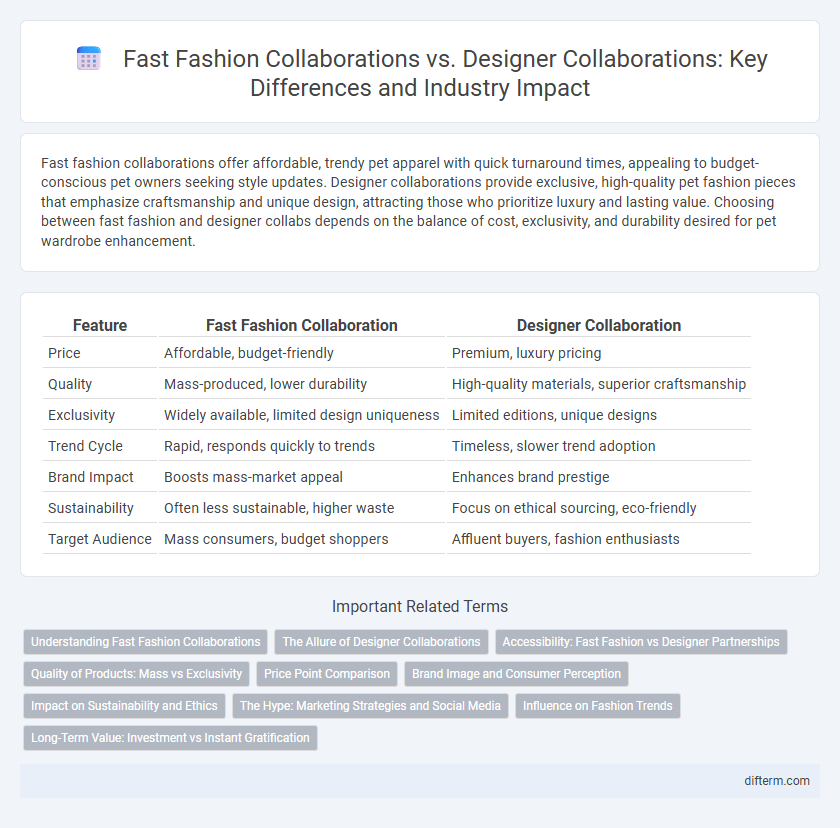Fast fashion collaborations offer affordable, trendy pet apparel with quick turnaround times, appealing to budget-conscious pet owners seeking style updates. Designer collaborations provide exclusive, high-quality pet fashion pieces that emphasize craftsmanship and unique design, attracting those who prioritize luxury and lasting value. Choosing between fast fashion and designer collabs depends on the balance of cost, exclusivity, and durability desired for pet wardrobe enhancement.
Table of Comparison
| Feature | Fast Fashion Collaboration | Designer Collaboration |
|---|---|---|
| Price | Affordable, budget-friendly | Premium, luxury pricing |
| Quality | Mass-produced, lower durability | High-quality materials, superior craftsmanship |
| Exclusivity | Widely available, limited design uniqueness | Limited editions, unique designs |
| Trend Cycle | Rapid, responds quickly to trends | Timeless, slower trend adoption |
| Brand Impact | Boosts mass-market appeal | Enhances brand prestige |
| Sustainability | Often less sustainable, higher waste | Focus on ethical sourcing, eco-friendly |
| Target Audience | Mass consumers, budget shoppers | Affluent buyers, fashion enthusiasts |
Understanding Fast Fashion Collaborations
Fast fashion collaborations leverage rapid production cycles and affordable pricing to bring designer-inspired trends to a broader audience quickly, emphasizing accessibility and trend responsiveness. These partnerships often feature limited-edition collections that drive consumer excitement and increase brand visibility without the high costs associated with traditional designer collaborations. Understanding the balance between innovation and mass-market appeal is crucial for assessing the commercial impact of fast fashion collaborations in the contemporary fashion industry.
The Allure of Designer Collaborations
Designer collaborations captivate fashion enthusiasts by merging luxury craftsmanship with distinct creative visions, elevating limited-edition collections into coveted statements of style. These partnerships often result in exclusive, high-quality pieces that embody innovation and brand heritage, appealing to consumers seeking both prestige and uniqueness. Unlike fast fashion collabs, designer collaborations emphasize enduring value and artistic expression, driving desire through exclusivity and elevated aesthetics.
Accessibility: Fast Fashion vs Designer Partnerships
Fast fashion collaborations prioritize accessibility by offering trendy designs at affordable prices, enabling wider consumer reach and rapid market turnover. Designer partnerships, while often exclusive and priced higher, emphasize unique craftsmanship and limited-edition appeal, targeting niche audiences willing to invest in quality and brand prestige. The contrast in accessibility reflects divergent business models: fast fashion maximizes volume through price and availability, whereas designer collabs focus on scarcity and brand elevation.
Quality of Products: Mass vs Exclusivity
Fast fashion collaborations prioritize mass production, resulting in lower quality materials and construction to meet high volume demands. Designer collaborations emphasize exclusivity, using premium fabrics and meticulous craftsmanship to create durable, high-end pieces. This contrast highlights the trade-off between affordability and lasting value in fashion partnerships.
Price Point Comparison
Fast fashion collaborations typically feature lower price points ranging from $20 to $150, making designer styles accessible to a broader audience. Designer collaborations generally command premium pricing between $200 and $1,000 due to exclusive materials, craftsmanship, and brand prestige. This price disparity highlights the varying target markets and brand positioning between fast fashion and designer partnerships.
Brand Image and Consumer Perception
Fast fashion collaborations leverage mass-market appeal to boost brand visibility but often face criticism for lacking exclusivity, which can dilute brand image among discerning consumers. Designer collaborations elevate brand prestige and signal high-quality craftsmanship, enhancing consumer perception of luxury and authenticity. Consumers tend to value designer collabs for their uniqueness and status, while fast fashion partnerships prioritize accessibility and trend responsiveness.
Impact on Sustainability and Ethics
Fast fashion collaborations often prioritize rapid production and low costs, leading to increased waste and questionable labor practices, which significantly harm sustainability and ethics in the fashion industry. Designer collaborations emphasize quality materials, limited releases, and ethical manufacturing, promoting circular fashion principles and reducing environmental impact. Choosing designer collaborations supports transparency and longevity, making them more aligned with sustainable and ethical values than fast fashion partnerships.
The Hype: Marketing Strategies and Social Media
Fast fashion collaborations leverage rapid production cycles and influencer marketing to create viral hype, often targeting Gen Z on platforms like TikTok and Instagram with limited-edition drops and user-generated content. Designer collaborations focus on exclusivity and craftsmanship storytelling, utilizing high-profile fashion shows and luxury brand ambassadors to generate buzz across digital campaigns and curated social content. Both strategies harness social media algorithms to amplify scarcity and desirability, driving immediate consumer engagement and sales.
Influence on Fashion Trends
Fast fashion collaborations with celebrities often accelerate trend adoption by offering accessible, affordable styles that quickly reach mass markets. Designer collaborations prioritize innovation and exclusivity, setting high-fashion standards that influence industry-wide aesthetics and seasonal collections. Both types of collaborations shape fashion trends, with fast fashion driving rapid consumer demand and designer partnerships fostering long-term trend evolution.
Long-Term Value: Investment vs Instant Gratification
Designer collaborations often provide long-term value by offering timeless, high-quality pieces that retain or increase in value over time. Fast fashion collaborations prioritize instant gratification with trendy, affordable items designed for short-term use and quick turnover. Investing in designer collabs supports sustainability and wardrobe longevity, while fast fashion collabs cater to immediate style trends without lasting durability.
Fast fashion collab vs Designer collab Infographic

 difterm.com
difterm.com